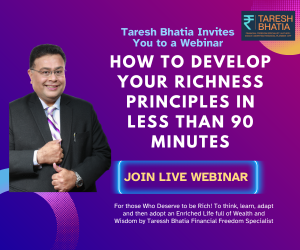Introduction: Why Passive Income Matters More Than Ever
I still remember a conversation I had with a client over coffee in Gurugram. He was 38, working in IT, and asked me point-blank:
“Taresh, if I stop working at 50, will my investments take care of me for the next 40 years?”
That’s when I realised — most people think of retirement as something far away, but in reality, planning for passive income is about buying freedom today. It’s not just about old age; it’s about securing your choices, dignity, and lifestyle.
Over the years, as a CFP, I’ve guided hundreds of families. Whether it’s a couple dreaming of early retirement in Goa, a single mother building a safety net, or a senior executive wondering if his PF is enough — the conversation constantly circles back to passive income.
Here are the 21 key factors you must consider when planning passive income for early or traditional retirement, enriched with stories, mistakes, and lessons I’ve seen firsthand.
#1. Objective – Define the Purpose of Your Passive Income
If you don’t know what you want from your passive income, no amount will ever feel enough.
One of my clients, a senior banker, wanted to retire at 52. His “objective” wasn’t just Money — it was to fund his daughter’s education abroad and spend six months a year in his farmhouse. Once we defined this clearly, his investments became aligned with purpose.
👉 Action Step: Write down whether your passive income is meant to cover basic needs, maintain lifestyle, or support dreams.
#2. Mindset – Patience and Discipline for Long-Term Wealth
I’ve seen young couples get excited about rental income, only to sell their property within three years because they couldn’t wait. Passive income is built on a mindset of patience.
One of my clients compared it beautifully: “It’s like planting a mango tree. You won’t eat mangoes next year, but once it fruits, it keeps giving.”
👉 Action Step: Train your mind to see passive income as a marathon, not a sprint.
#3. Horizon – Decide Your Timeframe
Are you planning to retire at 45, 55, or 65? The horizon changes everything.
A client of mine in Gurugram quit his corporate job at 47, but because his horizon was 40+ years, we had to plan much more aggressively. His corpus needed to sustain him longer than his parents ever imagined.
👉 Action Step: Decide your target retirement age and work backwards.
#4. Risk Appetite – Matching Investments with Comfort
One of my entrepreneur clients thought he had a high risk appetite until a minor stock market correction wiped 15% of his net worth. He lost sleep, even though we had a plan. That’s when he realised — risk tolerance is not what you say, it’s how you behave when things go wrong.
👉 Action Step: Test your risk appetite through real-life simulations and discussions, not just questionnaires.
#5. Household Expenses – Map Your Lifestyle Costs
Retirement is not about living cheaply; it’s about living with dignity. A retired army officer once told me, “I don’t want to cut my chai expenses just to save a few rupees.”
👉 Action Step: Write down your expected monthly expenses, add lifestyle choices (travel, hobbies), and adjust them for retirement.
#6. Inflation – The Silent Wealth Killer
In India, healthcare inflation is often twice the rate of expected inflation. A friend’s father retired with ₹ one crore, thinking it was enough. Today, his monthly medicines alone cost ₹25,000.
👉 Action Step: Always project expenses with 6–7% inflation in mind.
#7. Corpus Building – The Foundation of Passive Income
Passive income is only as substantial as the corpus behind it. I once explained to a client that a ₹ five crore corpus could generate ₹20 lakh a year at 4% safe withdrawal. His response was, “So it’s not magic, it’s math.”
👉 Action Step: Focus on building the most extensive sustainable corpus.
#8. Systematic Withdrawal Plan – Smart Payouts
Many investors think they’ll “sell a bit” when needed. That’s dangerous. Without a structured withdrawal plan, you risk outliving your Money.
👉 Action Step: Explore SWPs (Systematic Withdrawal Plans) in mutual funds or laddered bond maturities.
#9. Reviews – Periodic Adjustments
I had a client who didn’t review his investments for 7 years. By then, his portfolio had drifted far from his retirement goals. Passive income requires active reviews.
👉 Action Step: Review at least annually with your advisor.
#10. Be Relevant and Updated – Stay Current
Tax rules, interest rates, and investment products change. For example, many of my clients were shocked when long-term capital gains on equities were reintroduced.
👉 Action Step: Stay updated, or have a planner do it for you.
#11. Keep FAMILY Aware – Share the Blueprint
A client passed away suddenly, and his wife had no idea about the investments. It took months to trace documents. That’s when I started insisting: “Your family must know the basics.”
👉 Action Step: Maintain a family financial folder with key contacts and passwords.
#12. White Goods Replacement Fund – Plan for Appliances
It may sound small, but I’ve seen retirees panic when they had to replace a fridge or AC. These expenses add up.
👉 Action Step: Keep a sinking fund for appliances, furniture, and cars.
#13. Professional Will – Smooth Wealth Transfer
One of my clients fought a 5-year court battle with his siblings over property because his father didn’t leave a clear will. Don’t make that mistake.
👉 Action Step: Draft a professional will with a lawyer.
#14. Plan for Incapacity – Who Manages If You Can’t?
I’ve seen families stuck because the primary earning member became bedridden, and no one had the authority to operate bank accounts.
👉 Action Step: Create a Power of Attorney or assign a trusted nominee.
#15. Future-Proof Banking – Tech-Ready Access
With UPI and digital banking, access is easier today — but what about 20 years later? Will your spouse know how to manage it?
👉 Action Step: Ensure simple, future-proof systems with automation.
#16. Healthcare Costs – The Rising Burden
Healthcare is one area where no one should compromise. A Gurgaon couple I know had their retirement derailed because a single surgery cost ₹20 lakh.
👉 Action Step: Get adequate health insurance and medical buffer funds.
#17. Longevity Planning – Outliving Your Money
I often joke with clients: “Retirement is not 20 years anymore — it’s 40 years.” With life expectancy rising, you may spend more years retired than working.
👉 Action Step: Plan for 100 years of life, even if you expect less.
#18. Tax Efficiency – Minimise Outgo
One client had excellent rental income but was surprised to see half of it go toward taxes. We restructured his portfolio into tax-efficient instruments.
👉 Action Step: Factor tax on each passive income stream.
#19. Diversification of Income Sources – Don’t Depend on One
Rental income alone? Dangerous. Dividend income alone? Risky.
👉 Action Step: Build 3–4 different income streams.
#20. Contingency Fund – Always Keep Cash
During COVID-19, a retired couple in Gurugram had to sell mutual funds at a loss because they had no emergency fund.
👉 Action Step: Keep 12–24 months’ expenses in liquid funds/FDs.
#21. Professional Consultant – Guidance is Gold
Even the most intelligent DIY investor can miss blind spots. That’s why I always say: “Have a team.”
- Get a financial plan made from a CFP
- Use a mutual fund distributor for execution and monitoring
- Work with your CA for tax and compliance
👉 Action Step: Build your financial advisory circle.
Conclusion: Passive Income is the New Retirement Currency
Retirement isn’t about stopping work; it’s about working on your own terms. Passive income gives you that freedom. Whether you retire early at 45 or traditionally at 60, these 21 factors are your compass.
I tell my clients, “Money is not just for survival. It’s to live with dignity, joy, and freedom.”
Disclaimer: The views expressed are for educational purposes only and do not constitute financial, investment, tax, or legal advice. Please consult qualified professionals before making decisions. Mutual fund investments are subject to market risks.
👉 Full Disclaimer | Disclosures | Terms of Use
| 👉Join my FAN page at: | facebook.com/CFPTareshBhatia |
| 👉Follow on Facebook: | facebook.com/TareshBhatiaCFPro |
| 👉Follow me on Instagram: | instagram.com/tareshbhatiacfp |
| 👉Follow me on Threads: | threads.net/@tareshbhatiacfp |
| 👉Follow me on Twitter: | twitter.com/tareshbhatiacfp |
| 👉Follow me on LinkedIn: | linkedin.com/in/tareshbhatiacfp |
| 👉Visit Website: | tareshbhatia.com |
| 👉Read Blog: | blog.tareshbhatia.com |
| 👉Buy my Book: | pages.razorpay.com/BookTRP |
| 👉Join me on Telegram: | t.me/+v0ewUJQU0wowN2Jl |
| 👉YouTube Channel: | youtube.com/@Taresh-Bhatia |
| 👉Subscribe: | tinyurl.com/SubscTB |
| 👉Join my Academy: | therichnessacademy.com |
| 👉Complimentary Session-Limited Offer: | learn.therichnessacademy.com/web/checkout/686f9d1203ac6c6374689439 |
| 👉WhatsApp message directly: | wa.me/919810127906 |
| 👉Get Ebook: | tinyurl.com/TenEbook |
The author of this article, Taresh Bhatia, is a Certified Financial Planner® and advocate for female empowerment. For more information and personalized financial guidance, please contact taresh@tareshbhatia.com
He has authored an Amazon best seller-“The Richness Principles”. He is the Coach and founder of The Richness Academy, an online coaching courses forum. This article serves educational purposes only and does not constitute financial advice. Consultation with a qualified financial professional is recommended before making any investment decisions. An educational purpose article only and not any advice whatsoever.
©️2025: All Rights Reserved. Taresh Bhatia. Certified Financial Planner®
Subscribe Now for Upcoming Blogs!
[convertkit form=6555951]
📢 Join free live webinar —
Couple Finance Formula™ Register here




